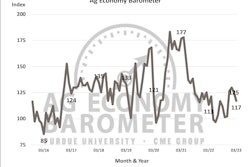
Beef and pork exports brought record returns to the U.S. corn and soybean industries in 2022 noted an independent study conducted by World Perspectives, Inc. and released by the U.S. Meat Export Federation (USMEF).
U.S. pork and beef exports contributed an estimated total economic impact of 15% per bushel to the value of corn and 13% per bushel to soybeans in 2022, according to the study.
“For every bushel of corn we marketed in 2022, a little over $1 was attributed to red meat exports. With soybeans, pork exports contributed $1.94 per bushel,” says USMEF chair Dean Meyer, who produces corn, soybeans, cattle and hogs near Rock Rapids, Iowa. “Pork and beef exports bring critical support to our bottom lines.”
But what does it mean if the U.S. is producing less red meat to export?
 Courtesy of U.S. Meat Export Federation
Courtesy of U.S. Meat Export FederationUSDA: Red meat production on the decline
In its latest Cattle & Beef Market Outlook, USDA noted total red meat and poultry production in 2023 is forecast to decrease for the first time in nearly a decade.
This is mostly due to the 6% decline in beef production that more than offsets forecast increases in pork (2%), broiler meat (1%), and turkey (7%) production.
Tightening cattle supplies are expected to cause a significant year-over-year decrease in beef production, the first decline since 2015, said the USDA report. After two consecutive years of decline, commercial pork production is forecast to increase in 2023 on higher slaughter and fractionally higher carcass weights.
According to reports, when extreme drought hit the U.S. in recent years, farmers started to rapidly sell cattle because the dry conditions, along with higher feed costs, increased the costs to maintain herds. That wave of sales, particularly of cows used to breed, has led to supply constraints in 2023.
Key findings from beef, pork export study
Key findings from the USMEF study, which used 2022 statistics provided by USDA’s National Agricultural Statistics Service and data analysis by World Perspectives, include:
Exporting corn through U.S. beef and pork
- Beef and pork exports accounted for 503.4 million bushels of U.S. corn usage, which equated to a market value of $3.4 billion (at an average corn price of $6.75/bushel)
- Beef and pork exports accounted for 3.42 million tons of DDGS usage, equating to $834 million (at an average price of $244/ton)
- Beef and pork exports contributed an estimated total economic impact of 15%, or $1.01, of bushel value in 2022 at an average price of $6.75/bushe
Exporting soybeans through U.S. pork
- Pork exports accounted for 89.7 million bushels of U.S. soybean usage, which equated to a market value of $1.33 billion (at an average price of $14.83/bushel)
- Pork exports contributed an estimated total economic impact of 13% of bushel value, or $1.94, in 2022 at an average price of $14.83/bushel
Corn and soybean growers support the international promotion of U.S. pork, beef and lamb by investing a portion of their checkoff dollars in market development efforts conducted by USMEF, said Dave Juday, senior analyst for World Perspectives.
“We are a major exporter of corn and soybeans but this study reminds us of the value of our indirect exports of corn and soybeans through pork and beef,” said Juday.
“The contributions of pork and beef exports to the per-bushel value of U.S. corn and soybeans in 2022 were the highest estimates we’ve seen to date," he continued. "And that was critically important, as corn and soybean farmers worked to maintain margins with higher input costs across the board.”

















